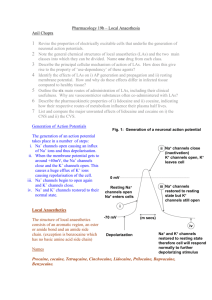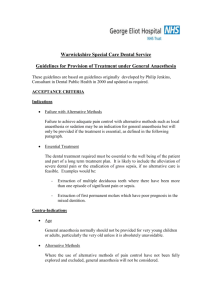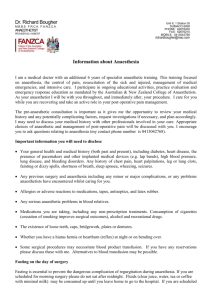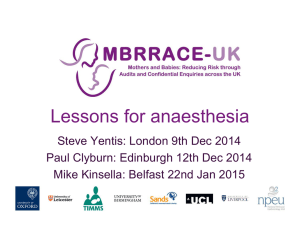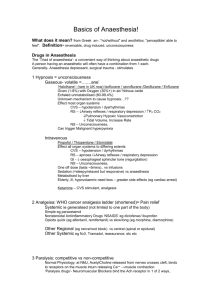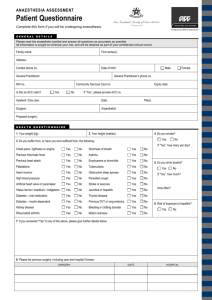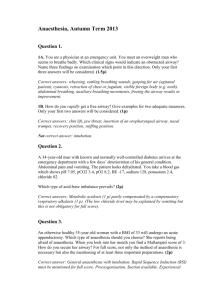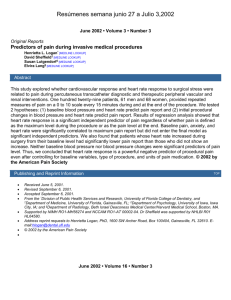CASE REPORT
advertisement
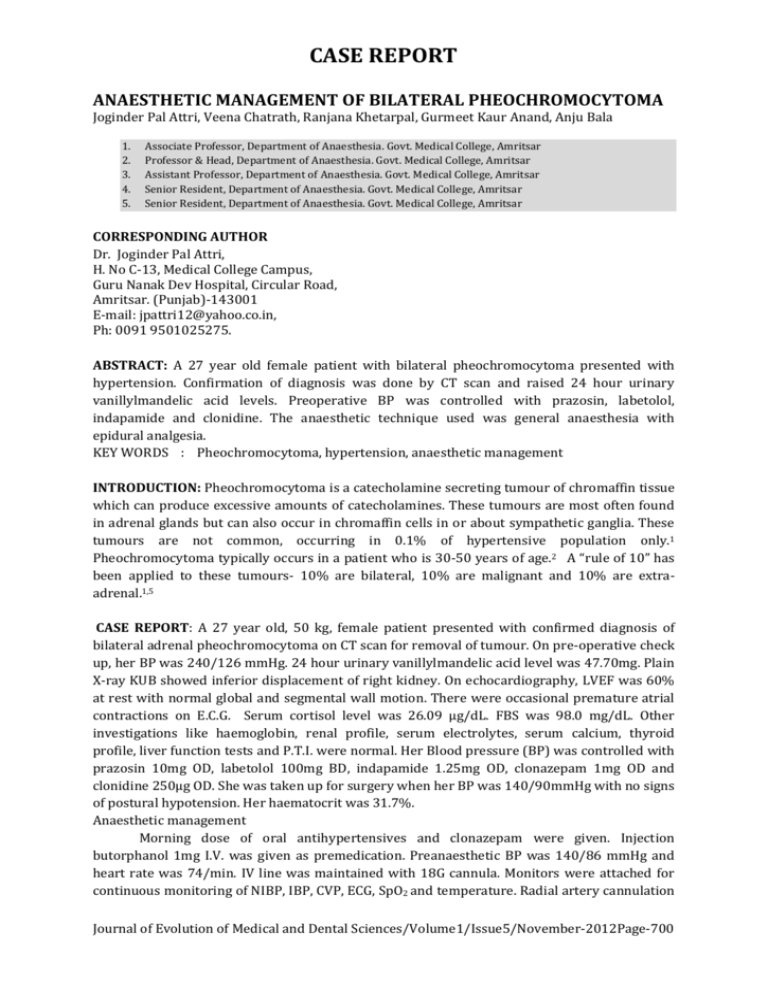
CASE REPORT ANAESTHETIC MANAGEMENT OF BILATERAL PHEOCHROMOCYTOMA Joginder Pal Attri, Veena Chatrath, Ranjana Khetarpal, Gurmeet Kaur Anand, Anju Bala 1. 2. 3. 4. 5. Associate Professor, Department of Anaesthesia. Govt. Medical College, Amritsar Professor & Head, Department of Anaesthesia. Govt. Medical College, Amritsar Assistant Professor, Department of Anaesthesia. Govt. Medical College, Amritsar Senior Resident, Department of Anaesthesia. Govt. Medical College, Amritsar Senior Resident, Department of Anaesthesia. Govt. Medical College, Amritsar CORRESPONDING AUTHOR Dr. Joginder Pal Attri, H. No C-13, Medical College Campus, Guru Nanak Dev Hospital, Circular Road, Amritsar. (Punjab)-143001 E-mail: jpattri12@yahoo.co.in, Ph: 0091 9501025275. ABSTRACT: A 27 year old female patient with bilateral pheochromocytoma presented with hypertension. Confirmation of diagnosis was done by CT scan and raised 24 hour urinary vanillylmandelic acid levels. Preoperative BP was controlled with prazosin, labetolol, indapamide and clonidine. The anaesthetic technique used was general anaesthesia with epidural analgesia. KEY WORDS : Pheochromocytoma, hypertension, anaesthetic management INTRODUCTION: Pheochromocytoma is a catecholamine secreting tumour of chromaffin tissue which can produce excessive amounts of catecholamines. These tumours are most often found in adrenal glands but can also occur in chromaffin cells in or about sympathetic ganglia. These tumours are not common, occurring in 0.1% of hypertensive population only.1 Pheochromocytoma typically occurs in a patient who is 30-50 years of age.2 A “rule of 10” has been applied to these tumours- 10% are bilateral, 10% are malignant and 10% are extraadrenal.1,5 CASE REPORT: A 27 year old, 50 kg, female patient presented with confirmed diagnosis of bilateral adrenal pheochromocytoma on CT scan for removal of tumour. On pre-operative check up, her BP was 240/126 mmHg. 24 hour urinary vanillylmandelic acid level was 47.70mg. Plain X-ray KUB showed inferior displacement of right kidney. On echocardiography, LVEF was 60% at rest with normal global and segmental wall motion. There were occasional premature atrial contractions on E.C.G. Serum cortisol level was 26.09 µg/dL. FBS was 98.0 mg/dL. Other investigations like haemoglobin, renal profile, serum electrolytes, serum calcium, thyroid profile, liver function tests and P.T.I. were normal. Her Blood pressure (BP) was controlled with prazosin 10mg OD, labetolol 100mg BD, indapamide 1.25mg OD, clonazepam 1mg OD and clonidine 250µg OD. She was taken up for surgery when her BP was 140/90mmHg with no signs of postural hypotension. Her haematocrit was 31.7%. Anaesthetic management Morning dose of oral antihypertensives and clonazepam were given. Injection butorphanol 1mg I.V. was given as premedication. Preanaesthetic BP was 140/86 mmHg and heart rate was 74/min. IV line was maintained with 18G cannula. Monitors were attached for continuous monitoring of NIBP, IBP, CVP, ECG, SpO2 and temperature. Radial artery cannulation Journal of Evolution of Medical and Dental Sciences/Volume1/Issue5/November-2012Page-700 CASE REPORT and right subclavian central line insertion was done. Initial CVP was 8 cm H2O. 18G epidural catheter was inserted in L2/3 inter-vertebral space and after a test dose of 3ml injection lignocaine 2% with 1:200000 adrenaline, 10ml of 0.5% plain bupivacaine with 50µg clonidine was given. Urinary catheterisation was done. After preoxygenation for three minutes, patient was induced with propofol 100mg, vecuronium 5 mg, N2O :O2 (50:50) and isoflurane 1%. 75mg xylocard was given one minute before laryngoscopy to avoid stress response and intubation was done. EtCO2 monitoring was done throughout surgery. Maintenance of anaesthesia was done with O2:N2O, isoflurane, vecuronium and positive pressure ventilation. Intra-operative BP surge of >200/110mmHg was controlled by 0.01% infusion of sodium nitroprusside (SNP) and heart rate more than 100/min by intermittent bolus of metoprolol 2 mg. After three hours of surgery, 10ml of 0.5% plain bupivacaine was given through epidural catheter. After the removal of tumour, there was precipitous fall of BP and the same was restored by rapid infusion of Ringer lactate 2.5L, Haemaccel 500 ml, 2 units of blood and noradrenaline infusion. Injection hydrocortisone 200mg was given after removal of the tumour. Urine output was maintained throughout the procedure. At the conclusion of the surgery, patient was reversed with neostigmine and glycopyrrolate and extubated. Patient was fully awake and maintained her vitals with support of noradrenaline. Post-operative analgesia continued through epidural catheter. Patient was shifted to ICU for continuous monitoring of vitals. Post-operative steroid cover was continued. Patient remained stable in ICU and in ward. She was discharged on 15 th day with stable BP. DISCUSSION: Primary pre-operative goal should be good pharmacological control of adverse effects of circulatory catecholamines and restoration of blood volume by α- adrenoreceptor blockade. Several authors suggest the use of calcium channel blockers (verapamil 120-240 mg every day, nifedipine 30-90 mg, diltiazem 180 mg daily) to prepare the patient in preoperative period. These agents do not cause postoperative hypotension and can control the rhythm and heart rate. 7,8 Our patient was given prazosin, a selective α-blocker that causes less tachycardia and postural hypotension than other α-adrenoreceptor blockers.4 Labetalol was added later on to control tachycardia. Another approach involves the administration of metyrosine (alphamethyl-para-tyrosine), which inhibits catecholamine synthesis. In one report, the patients given metyrosine had a smoother perioperative course than those given phenoxybenzamine alone.9 The main aim of anaesthetic management is to provide optimal surgical conditions and suppress the response of endotracheal intubation, surgical stimulation, tumour handling and devascularisation. Combined regional and general anaesthetic technique is preferred, so we used epidural anaesthesia with general anaesthesia to expand the vascular bed and provide preemptive and post-operative analgesia4. It is most appropriate to administer an anxiolytic sedative preferably a benzodiazepine to decrease catecholamine release.3 Our patient was already taking clonazepam so we gave 1mg IV butorphanol as premedication. Monitoring in our case was performed as per recommendation.1 Drugs causing histamine release were avoided. The anaesthetic agents preferred were propofol, isoflurane and nitrous oxide. Isoflurane was used in our patient because it does not sensitise the heart to catecholamines and decreases the peripheral resistance too.1 Vecuronium was preferred as a relaxant due to it’s lack of cardiovascular effects and histamine release.1 Lignocaine 1.5mg/kg IV was given 1 minute before laryngoscopy to attenuate the stress response.2 To control BP and tachycardia, we used continuous IV infusion of SNP and metoprolol IV boluses. There are recent reports of usage of I/V infusions of dexmedetomidine and magnesium sulphate in perioperative management of Journal of Evolution of Medical and Dental Sciences/Volume1/Issue5/November-2012Page-701 CASE REPORT pheochromocytomas.6 Steroid cover is mandatory for patients undergoing bilateral adrenalectomy. We also used hydrocortisone in intra-operative and post-operative period. In conclusion, the proper anaesthetic management of pheochromocytoma is a truly rewarding challenge. Mortality has been reduced in recent years due to better knowledge of these bizarre tumours, particularly the chronic hypovolemia produced, and more adequate pretreatment regimens, better intra and post- operative management. REFERENCES: 1. Brown R. Brunell Jr. Anaesthesia for Pheochromocytoma. In: Robert C Prys and Brown R. Brunell Jr. Editors International practice of anaesthesia. 2. Stoelting RK, Dierdosrf SF. Endocrine diseases. Anaesthesia and Co-existing diseases 2002; 430-434. 3. Published – butterworth-Heinemann 1996; 1/83/1-7 G.Singh, P.Kam. An overview of anaesthetic issues in Pheochromocytoma.Ann acad Singapore 1998;27:843-8. 4. Roberts C. Prys. Pheochromocytoma- Recent progress in it’s management. Br J Anaesth 2000; 85(1): 44-57. 5. Joet T. Alder, Goswin Y et al. Phaeocchromocytoma: Current approaches and future directions. The Oncologist 2008; 13:779-793. 6. Bryskin R, Weldon BC. Dexmedetomidine and magnesium sulfate in the perioperative management of a child undergoing laparoscopic resection of bilateral pheochromocytomas. J Clin Anesth. 2010 Mar;22(2):126-9. 7. Domi R, Laho H. Management of pheochromocytoma: Old ideas and new drugs. Niger J Clin Pract 2012;15:253-7. 8. Lebuffe G, Dosseh ED, Tek G, Tytgat H, Moreno S, Tavernier B, et al. The effect of calcium channel blockers on outcome following the surgical treatment of pheochromocytomas and paragangliomas. Anaesthesia 2005;60:439-44. 9. Steinsapir J, Carr AA, Prisant LM, Bransome ED Jr. Metyrosine and pheochromocytoma. Arch Intern Med 1997; 157:901. Journal of Evolution of Medical and Dental Sciences/Volume1/Issue5/November-2012Page-702


